towing TOYOTA LAND CRUISER 2011 J200 Owners Manual
[x] Cancel search | Manufacturer: TOYOTA, Model Year: 2011, Model line: LAND CRUISER, Model: TOYOTA LAND CRUISER 2011 J200Pages: 608, PDF Size: 8.29 MB
Page 3 of 608
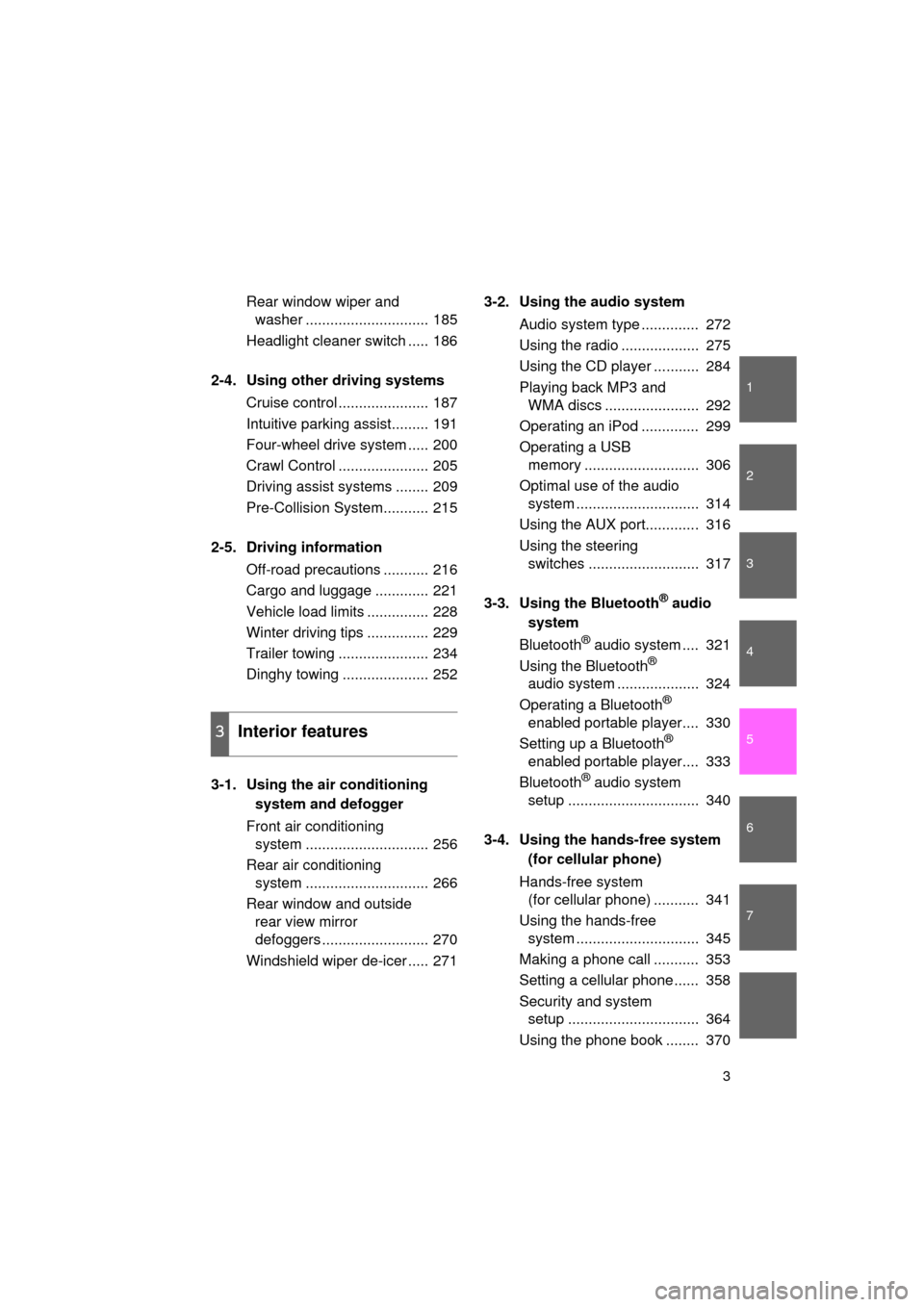
1
2
3
4
5
6
7
3
L/C200_U (OM60F74U)
Rear window wiper and washer .............................. 185
Headlight cleaner switch ..... 186
2-4. Using other driving systems Cruise control ...................... 187
Intuitive parking assist......... 191
Four-wheel drive system ..... 200
Crawl Control ...................... 205
Driving assist systems ........ 209
Pre-Collision System........... 215
2-5. Driving information Off-road precautions ........... 216
Cargo and luggage ............. 221
Vehicle load limits ............... 228
Winter driving tips ............... 229
Trailer towing ...................... 234
Dinghy towing ..................... 252
3-1. Using the air conditioning system and defogger
Front air conditioning system .............................. 256
Rear air conditioning system .............................. 266
Rear window and outside rear view mirror
defoggers .......................... 270
Windshield wiper de-icer ..... 271 3-2. Using the audio system
Audio system type .............. 272
Using the radio ................... 275
Using the CD player ........... 284
Playing back MP3 and WMA discs ....................... 292
Operating an iPod .............. 299
Operating a USB memory ............................ 306
Optimal use of the audio system .............................. 314
Using the AUX port............. 316
Using the steering switches ........................... 317
3-3. Using the Bluetooth
® audio
system
Bluetooth
® audio system .... 321
Using the Bluetooth®
audio system .................... 324
Operating a Bluetooth
®
enabled portable player.... 330
Setting up a Bluetooth
®
enabled portable player.... 333
Bluetooth
® audio system
setup ................................ 340
3-4. Using the hands-free system (for cellular phone)
Hands-free system (for cellular phone) ........... 341
Using the hands-free system .............................. 345
Making a phone call ........... 353
Setting a cellular phone ...... 358
Security and system setup ................................ 364
Using the phone book ........ 370
3Interior features
Page 143 of 608
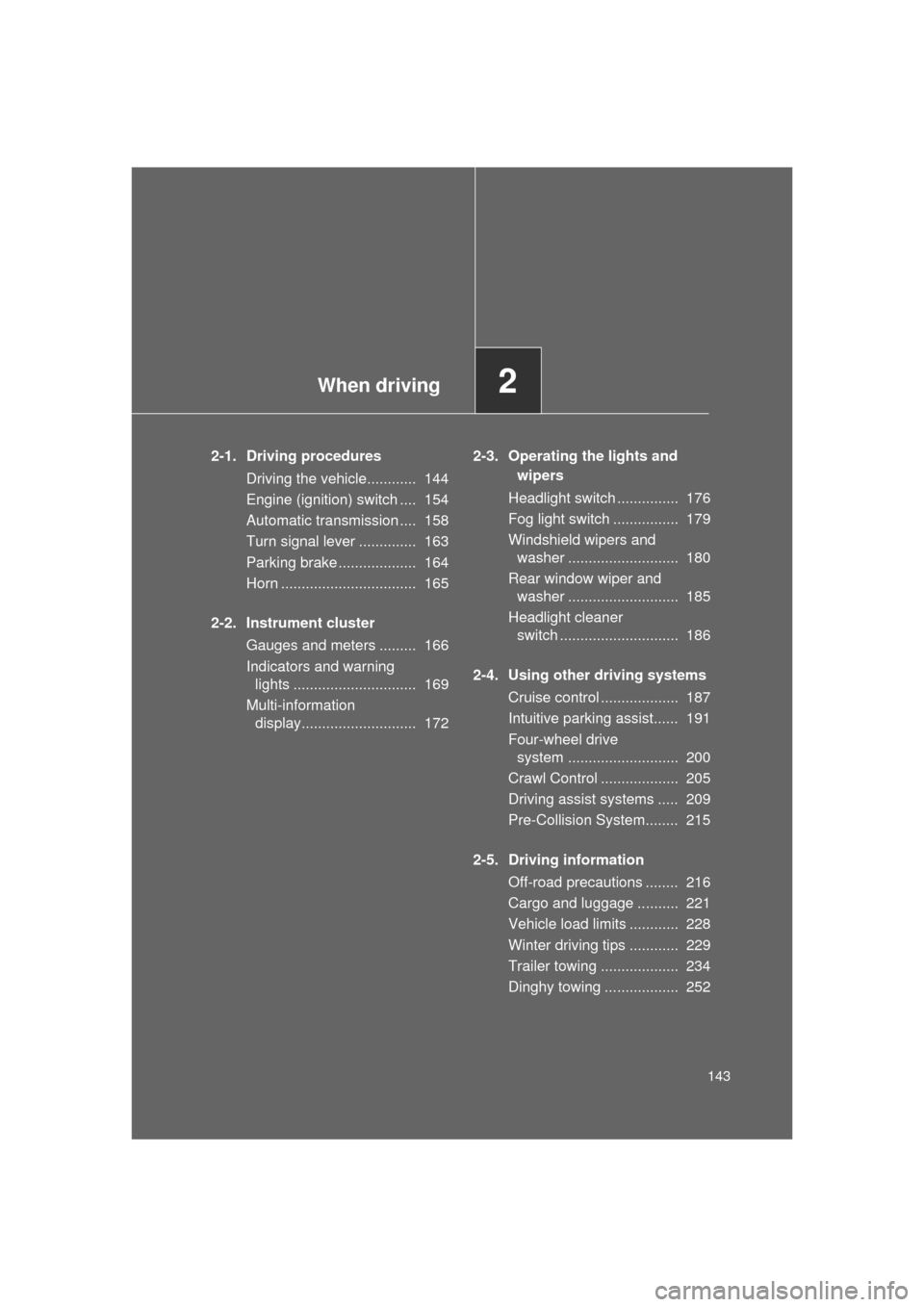
When driving2
143
L/C200_U (OM60F74U)
2-1. Driving proceduresDriving the vehicle............ 144
Engine (ignition) switch .... 154
Automatic transmission .... 158
Turn signal lever .............. 163
Parking brake ................... 164
Horn ................................. 165
2-2. Instrument cluster Gauges and meters ......... 166
Indicators and warning lights .............................. 169
Multi-information display............................ 172 2-3. Operating the lights and
wipers
Headlight switch ............... 176
Fog light switch ................ 179
Windshield wipers and washer ........................... 180
Rear window wiper and washer ........................... 185
Headlight cleaner switch ............................. 186
2-4. Using other driving systems Cruise control ................... 187
Intuitive parking assist...... 191
Four-wheel drive system ........................... 200
Crawl Control ................... 205
Driving assist systems ..... 209
Pre-Collision System........ 215
2-5. Driving information Off-road precautions ........ 216
Cargo and luggage .......... 221
Vehicle load limits ............ 228
Winter driving tips ............ 229
Trailer towing ................... 234
Dinghy towing .................. 252
Page 190 of 608
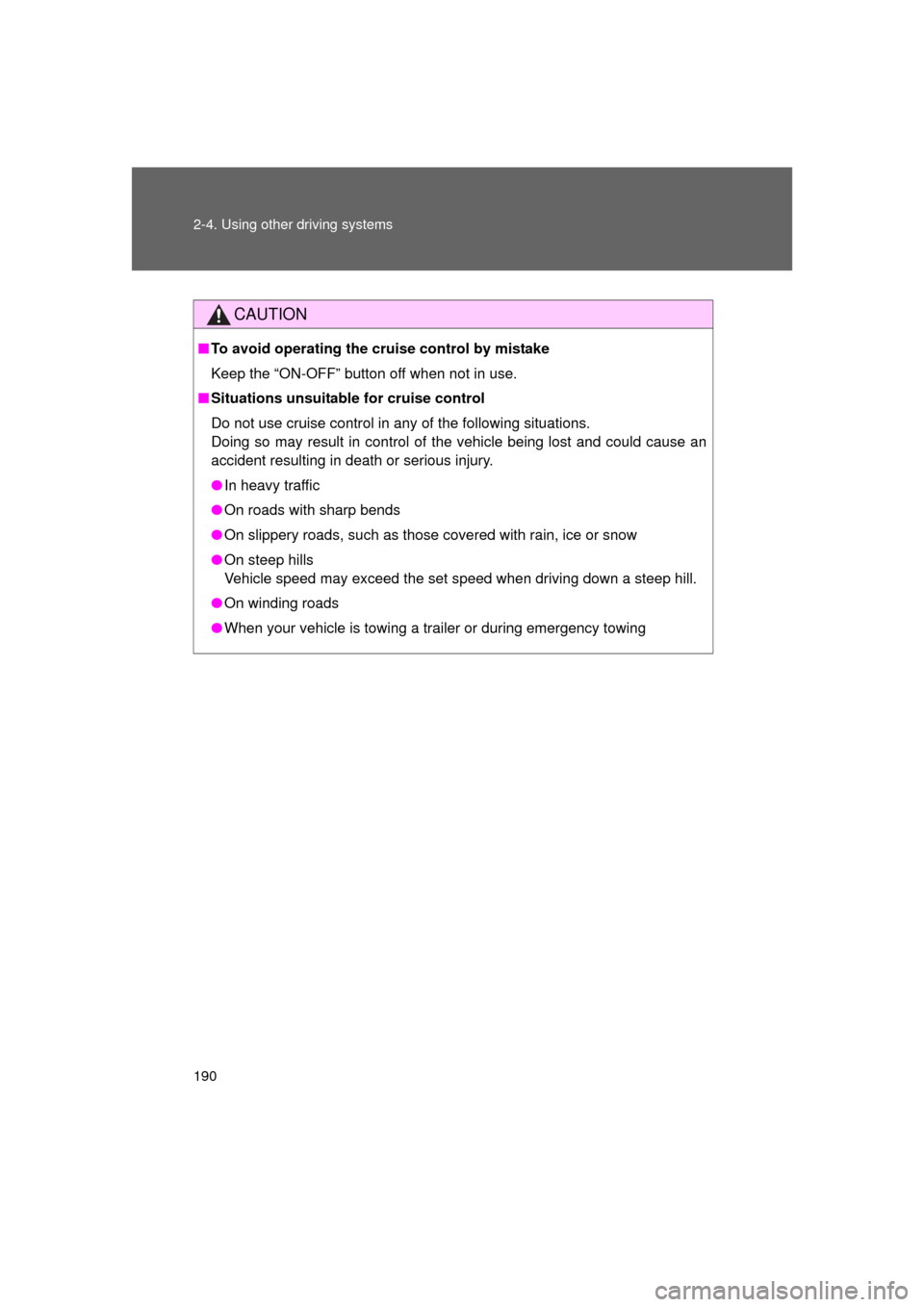
190 2-4. Using other driving systems
L/C200_U (OM60F74U)
CAUTION
■To avoid operating the cruise control by mistake
Keep the “ON-OFF” button off when not in use.
■ Situations unsuitable for cruise control
Do not use cruise control in any of the following situations.
Doing so may result in control of the vehicle being lost and could cause an
accident resulting in death or serious injury.
● In heavy traffic
● On roads with sharp bends
● On slippery roads, such as those covered with rain, ice or snow
● On steep hills
Vehicle speed may exceed the set speed when driving down a steep hill.
● On winding roads
● When your vehicle is towing a trailer or during emergency towing
Page 198 of 608
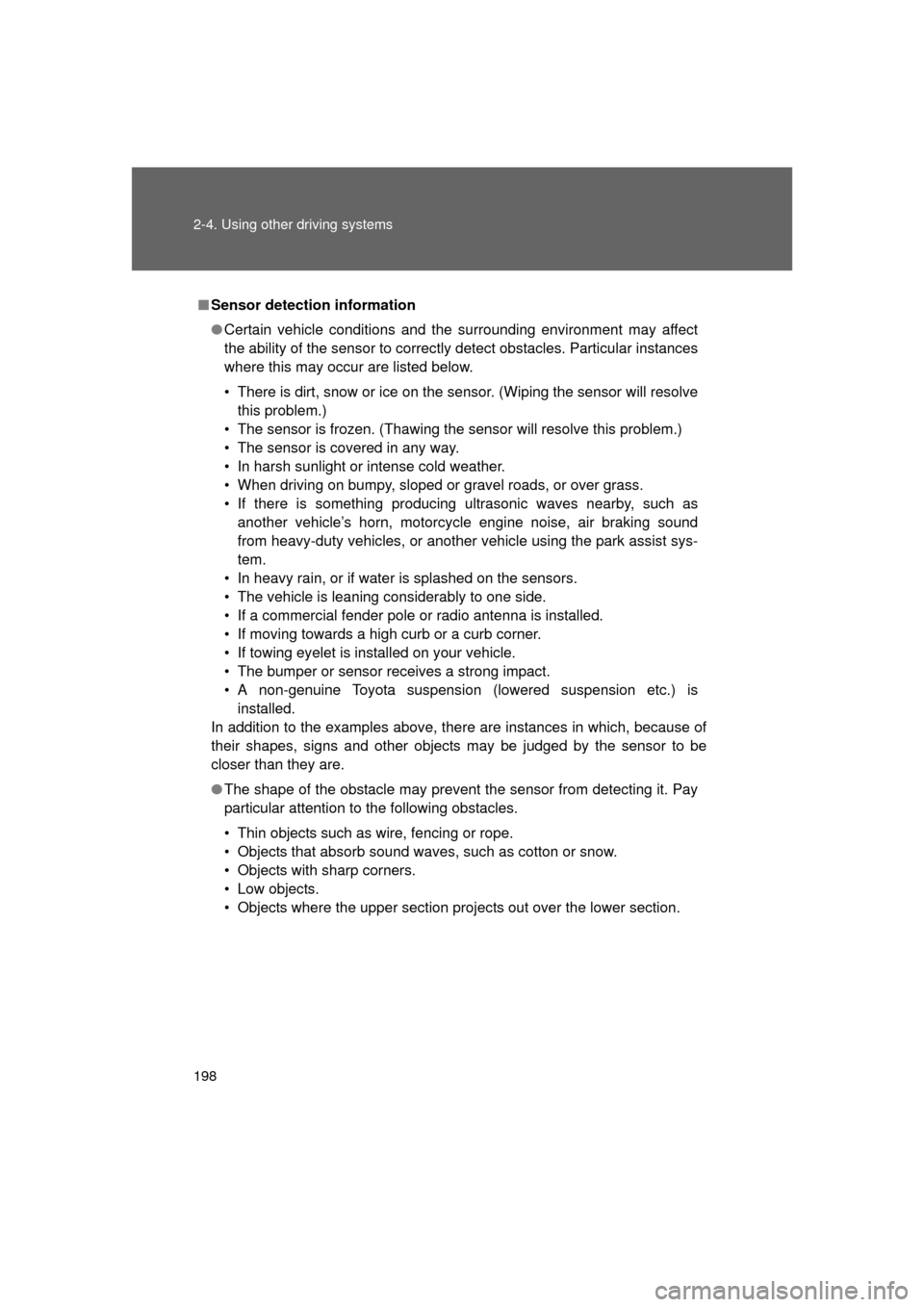
198 2-4. Using other driving systems
L/C200_U (OM60F74U)
■Sensor detection information
● Certain vehicle conditions and the surrounding environment may affect
the ability of the sensor to correctly detect obstacles. Particular instances
where this may occur are listed below.
• There is dirt, snow or ice on the sensor. (Wiping the sensor will resolve
this problem.)
• The sensor is frozen. (Thawing the sensor will resolve this problem.)
• The sensor is covered in any way.
• In harsh sunlight or intense cold weather.
• When driving on bumpy, sloped or gravel roads, or over grass.
• If there is something producing ultrasonic waves nearby, such as another vehicle’s horn, motorcycle engine noise, air braking sound
from heavy-duty vehicles, or another vehicle using the park assist sys-
tem.
• In heavy rain, or if water is splashed on the sensors.
• The vehicle is leaning considerably to one side.
• If a commercial fender pole or radio antenna is installed.
• If moving towards a high curb or a curb corner.
• If towing eyelet is installed on your vehicle.
• The bumper or sensor receives a strong impact.
• A non-genuine Toyota suspension (lowered suspension etc.) is installed.
In addition to the examples above, there are instances in which, because of
their shapes, signs and other objects may be judged by the sensor to be
closer than they are.
● The shape of the obstacle may prevent the sensor from detecting it. Pay
particular attention to the following obstacles.
• Thin objects such as wire, fencing or rope.
• Objects that absorb sound waves, such as cotton or snow.
• Objects with sharp corners.
• Low objects.
• Objects where the upper section projects out over the lower section.
Page 223 of 608
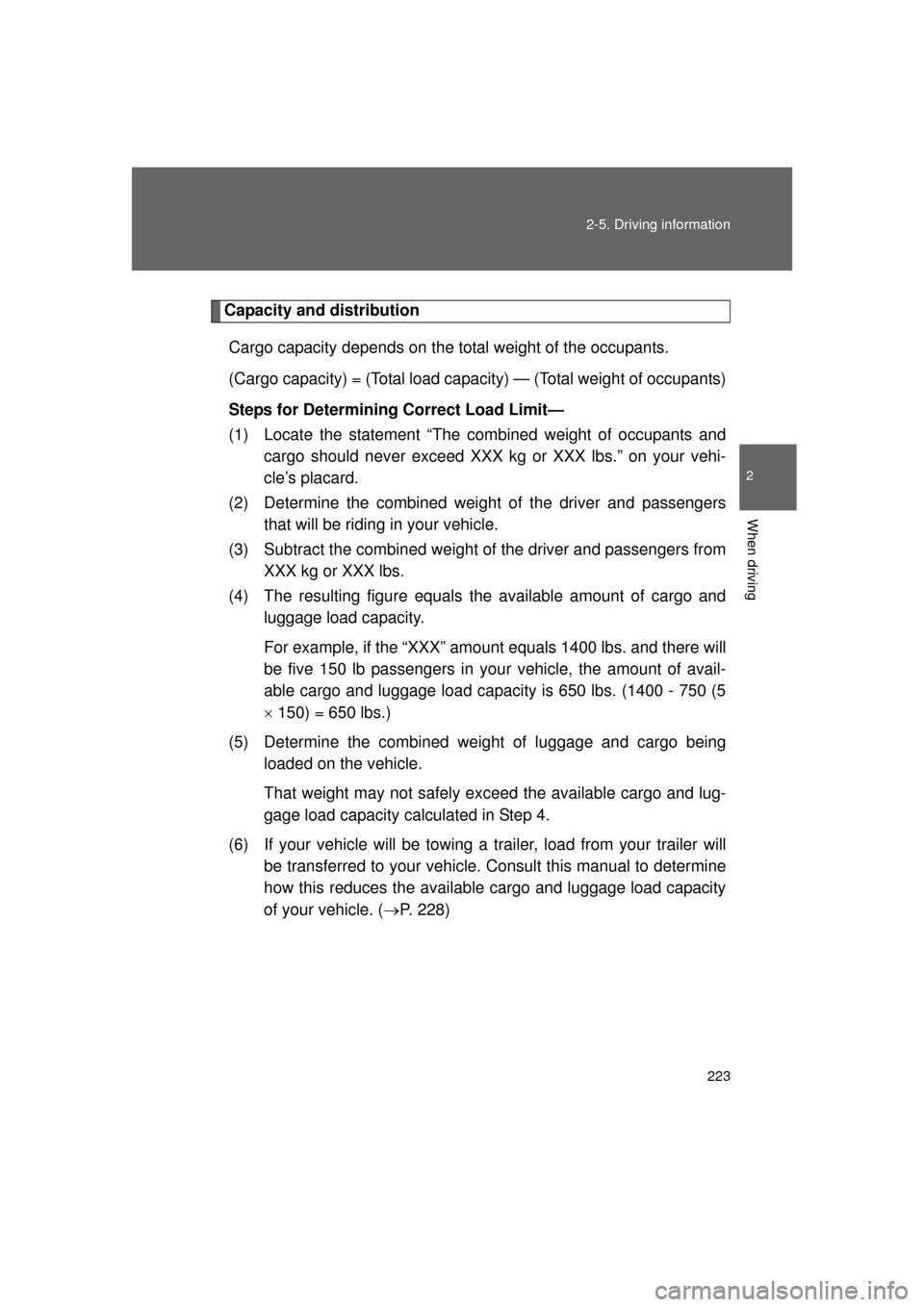
223
2-5. Driving information
2
When driving
L/C200_U (OM60F74U)
Capacity and distribution
Cargo capacity depends on the total weight of the occupants.
(Cargo capacity) = (Total load capa city) — (Total weight of occupants)
Steps for Determining Correct Load Limit—
(1) Locate the statement “The co mbined weight of occupants and
cargo should never exceed XXX kg or XXX lbs.” on your vehi-
cle’s placard.
(2) Determine the combined weight of the driver and passengers that will be riding in your vehicle.
(3) Subtract the combined weight of the driver and passengers from
XXX kg or XXX lbs.
(4) The resulting figure equals the available amount of cargo and luggage load capacity.
For example, if the “XXX” amount equals 1400 lbs. and there will
be five 150 lb passengers in your vehicle, the amount of avail-
able cargo and luggage load capacity is 650 lbs. (1400 - 750 (5
150) = 650 lbs.)
(5) Determine the combined weight of luggage and cargo being loaded on the vehicle.
That weight may not safely ex ceed the available cargo and lug-
gage load capacity calculated in Step 4.
(6) If your vehicle will be towing a tr ailer, load from your trailer will
be transferred to your vehicle. Consult this manual to determine
how this reduces the available cargo and luggage load capacity
of your vehicle. ( P. 228)
Page 234 of 608
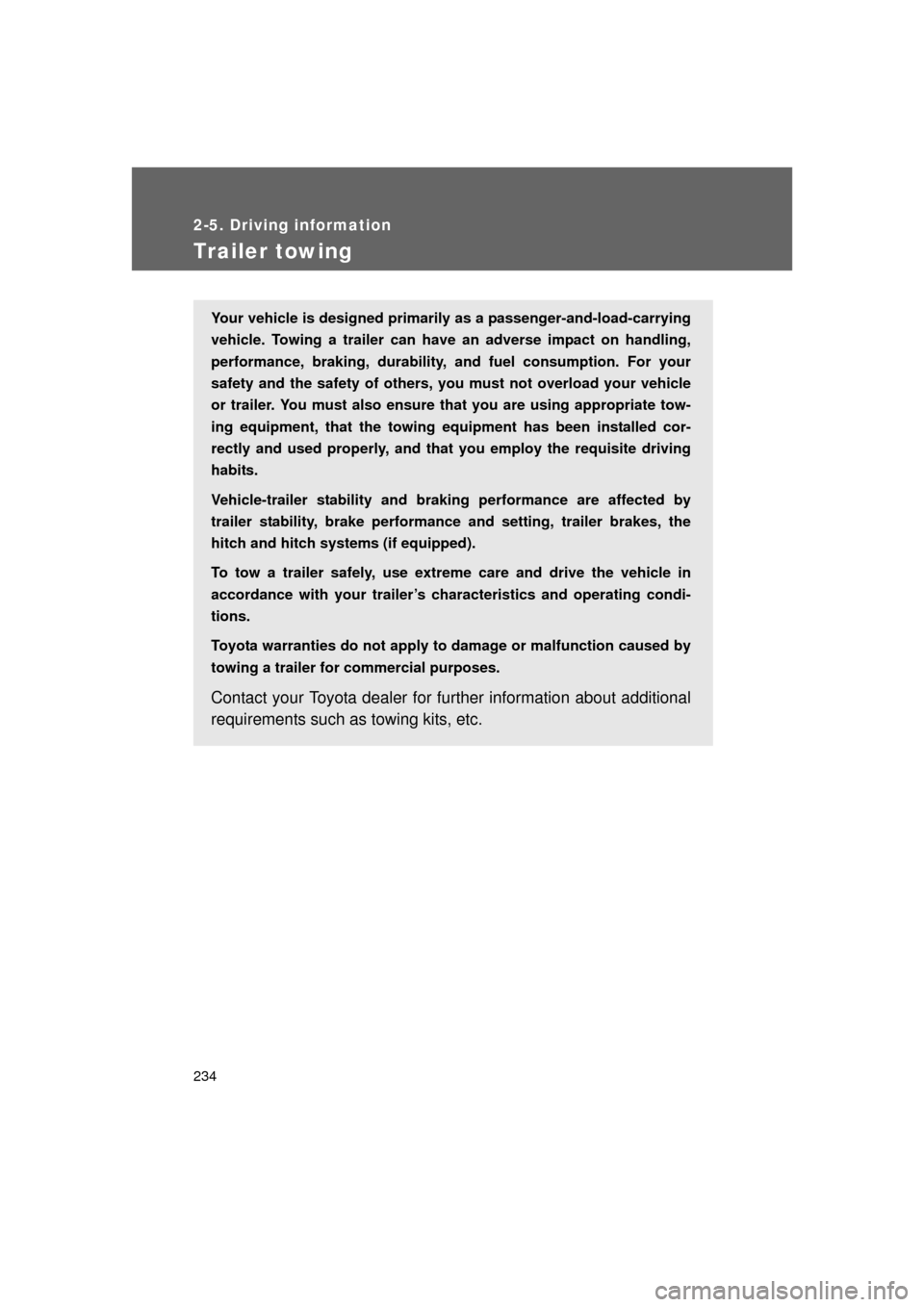
234
2-5. Driving information
L/C200_U (OM60F74U)
Trailer towing
Your vehicle is designed primarily as a passenger-and-load-carrying
vehicle. Towing a trailer can have an adverse impact on handling,
performance, braking, durability, and fuel consumption. For your
safety and the safety of others, you must not overload your vehicle
or trailer. You must also ensure that you are using appropriate tow-
ing equipment, that the towing eq uipment has been installed cor-
rectly and used properly, and that you employ the requisite driving
habits.
Vehicle-trailer stability and br aking performance are affected by
trailer stability, brake performance and setting, trailer brakes, the
hitch and hitch systems (if equipped).
To tow a trailer safely, use extreme care and drive the vehicle in
accordance with your trailer’s characteristics and operating condi-
tions.
Toyota warranties do not apply to damage or malfunction caused by
towing a trailer for commercial purposes.
Contact your Toyota dealer for fu rther information about additional
requirements such as towing kits, etc.
Page 235 of 608
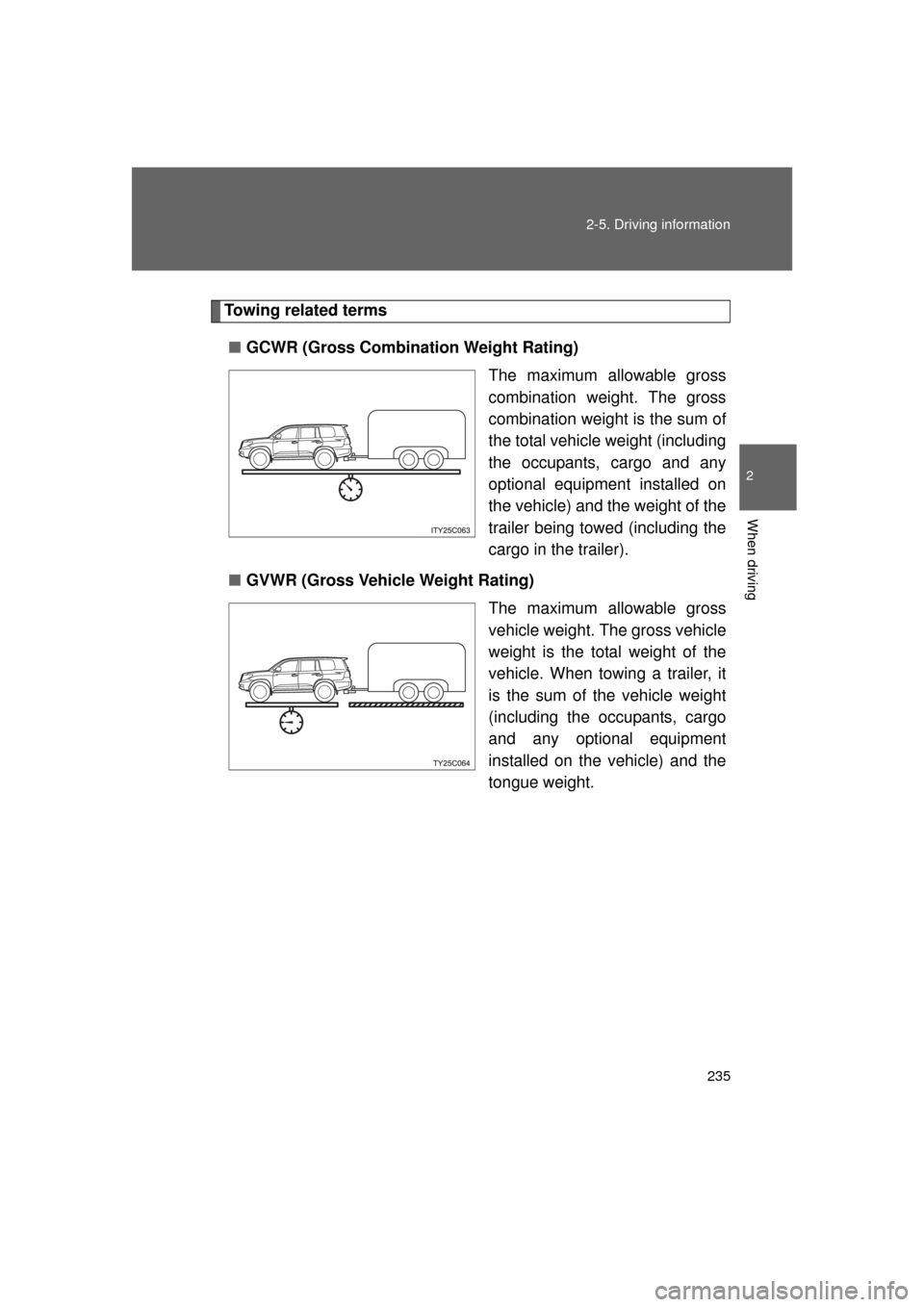
235
2-5. Driving information
2
When driving
L/C200_U (OM60F74U)
Towing related terms
■ GCWR (Gross Combination Weight Rating)
The maximum allowable gross
combination weight. The gross
combination weight is the sum of
the total vehicle weight (including
the occupants, cargo and any
optional equipment installed on
the vehicle) and the weight of the
trailer being towed (including the
cargo in the trailer).
■ GVWR (Gross Vehicle Weight Rating)
The maximum allowable gross
vehicle weight. The gross vehicle
weight is the total weight of the
vehicle. When towing a trailer, it
is the sum of the vehicle weight
(including the occupants, cargo
and any optional equipment
installed on the vehicle) and the
tongue weight.
Page 236 of 608
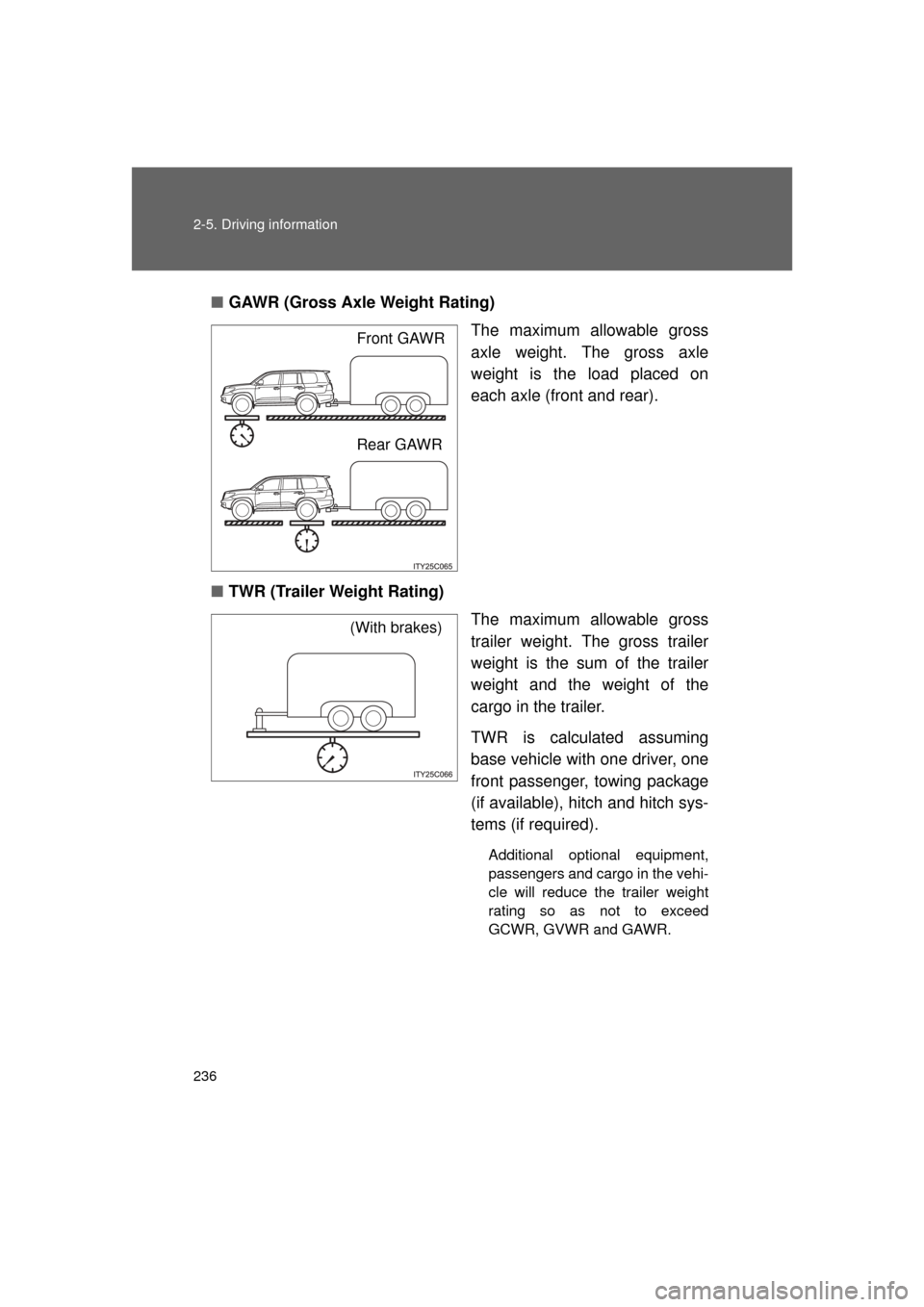
236 2-5. Driving information
L/C200_U (OM60F74U)■
GAWR (Gross Axle Weight Rating)
The maximum allowable gross
axle weight. The gross axle
weight is the load placed on
each axle (front and rear).
■ TWR (Trailer Weight Rating)
The maximum allowable gross
trailer weight. The gross trailer
weight is the sum of the trailer
weight and the weight of the
cargo in the trailer.
TWR is calculated assuming
base vehicle with one driver, one
front passenger, towing package
(if available), hitch and hitch sys-
tems (if required).
Additional optional equipment,
passengers and cargo in the vehi-
cle will reduce the trailer weight
rating so as not to exceed
GCWR, GVWR and GAWR.
Front GAWR
Rear GAWR
(With brakes)
Page 240 of 608
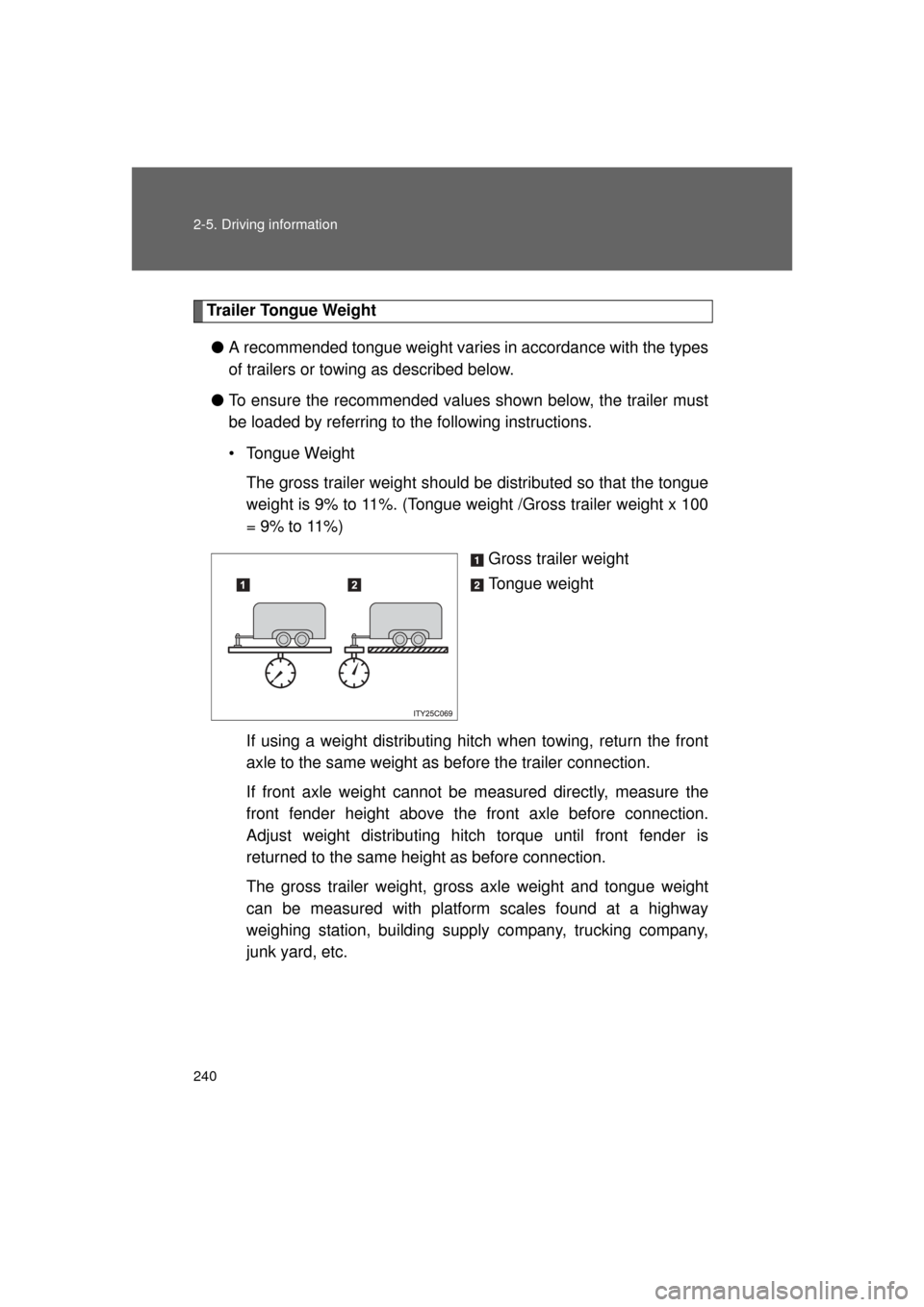
240 2-5. Driving information
L/C200_U (OM60F74U)
Trailer Tongue Weight● A recommended tongue weight varies in accordance with the types
of trailers or towing as described below.
● To ensure the recommended values shown below, the trailer must
be loaded by referring to the following instructions.
• Tongue Weight
The gross trailer weight should be distributed so that the tongue
weight is 9% to 11%. (Tongue we ight /Gross trailer weight x 100
= 9% to 11%)
Gross trailer weight
Tongue weight
If using a weight distributing hitch when towing, return the front
axle to the same weight as before the trailer connection.
If front axle weight cannot be measured directly, measure the
front fender height above th e front axle before connection.
Adjust weight distributing hitch torque until front fender is
returned to the same height as before connection.
The gross trailer weight, gross axle weight and tongue weight
can be measured with platform scales found at a highway
weighing station, building supply company, trucking company,
junk yard, etc.
Page 241 of 608
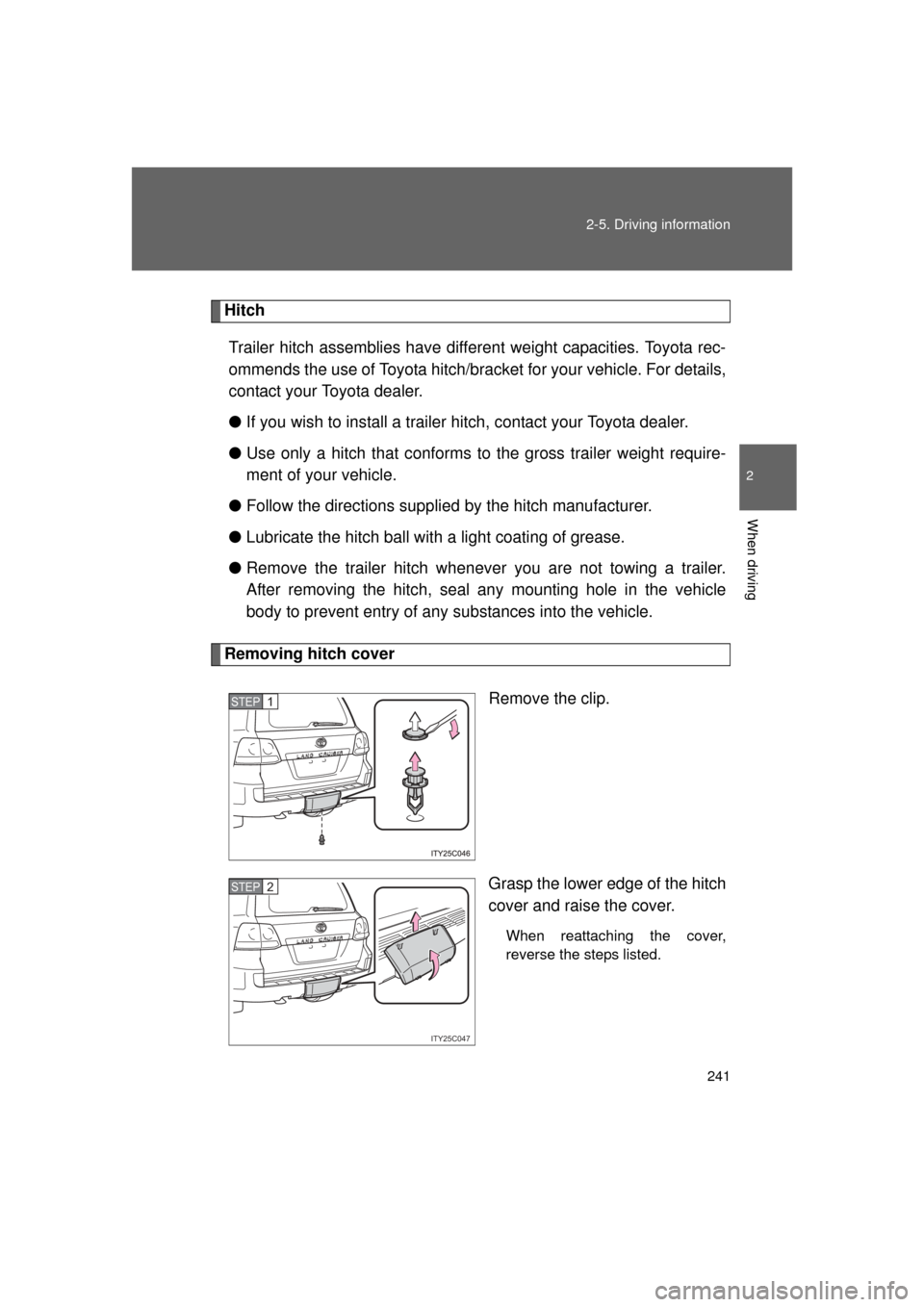
241
2-5. Driving information
2
When driving
L/C200_U (OM60F74U)
Hitch
Trailer hitch assemblies have different weight capacities. Toyota rec-
ommends the use of Toyota hitch/brac ket for your vehicle. For details,
contact your Toyota dealer.
● If you wish to install a trailer hitch, contact your Toyota dealer.
● Use only a hitch that conforms to the gross trailer weight require-
ment of your vehicle.
● Follow the directions supplied by the hitch manufacturer.
● Lubricate the hitch ball with a light coating of grease.
● Remove the trailer hitch whenever you are not towing a trailer.
After removing the hitch, seal any mounting hole in the vehicle
body to prevent entry of any substances into the vehicle.
Removing hitch cover
Remove the clip.
Grasp the lower edge of the hitch
cover and raise the cover.
When reattaching the cover,
reverse the steps listed.
STEP1
ITY25C047
STEP2